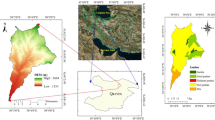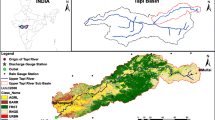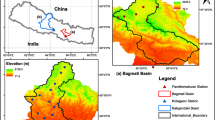Abstract
Digital elevation model (DEM) of a watershed forms key basis for hydrologic modelling and its resolution plays a key role in accurate prediction of various hydrological processes. This study appraises the effect of different DEMs with varied spatial resolutions (namely TOPO 20 m, CARTO 30 m, ASTER 30 m, SRTM 90 m, GEO-AUS 500 m and USGS 1000 m) on hydrological response of watershed using Soil and Water Assessment Tool (SWAT) and applied for a case study of Kaddam watershed in India for estimating runoff and sediment yield. From the results of case study, it was observed that reach lengths, reach slopes, minimum and maximum elevations, sub-watershed areas, land use mapping areas within the sub-watershed and number of HRUs varied substantially due to DEM resolutions, and consequently resulted in a considerable variability in estimated daily runoff and sediment yields. It was also observed that, daily runoff values have increased (decreased) on low (high) rainy days respectively with coarser resolution of DEM. The daily sediment yield values from each sub-watershed decreased with coarser resolution of the DEM. The study found that the performance of SWAT model prediction was not influenced much for finer resolution DEMs up to 90 m for estimation of runoff, but it certainly influenced the estimation of sediment yields. The DEMs of TOPO 20 m and CARTO 30 m provided better estimates of sub-watershed areas, runoff and sediment yield values over other DEMs.





Similar content being viewed by others
References
Abbaspour K 2013 SWAT Model CUP; www.eawag.ch/forschung/siam/software/swat/index.
APWALMTARI 2010 Andhra Pradesh Water and Land Management Training and Research Institute: Report on Hydrographic surveys of reservoirs in Adilabad district, Department of Irrigation and CAD, Govt. of Andhra Pradesh, Hyderabad.
Arnold J G, Srinivasan R, Muttiah R S and Williams J R 1998 Large area hydrologic modelling assessment. Part I: Model development; J. Am. Water Resour. Assoc. 34 (1) 73–89.
Arnold J G, Muttiah R S, Srinivasan R and Allen P M 2000 Regional estimation of base flow and groundwater recharge in the Upper Mississippi river basin; J. Hydrol. 227 (1–4) 21–40.
Arnold J G and Fohrer N 2005 SWAT2000: Current capabilities and research opportunities in applied watershed modelling; Hydrol. Process. 19 563–572.
Bormann H 2006 Impact of spatial data resolution on simulated catchment water balances and model performance of the multi-scale TOPLATS model; Hydrol. Earth Syst. Sci. 10 165–179.
Bormann H 2008 Sensitivity of a soil–vegetation–atmosphere transfer scheme to input data resolution and data classification; J. Hydrol. 351 154–169.
Bormann H, Breuer L, Graff T, Huisman J A and Croke B 2009 Assessing the impact of land use change on hydrology by ensemble modelling (LUCHEM) IV: Model sensitivity to data aggregation and spatial (re-)distribution; Adv. Water Resour. 32 171–192.
Brown D G, Bian L and Walsh S J 1993 Response of a distributed watershed erosion model to variations in input data aggregation levels; Comput. Geosci. 19 499– 509.
Bruneau P, Gascuel-Odoux C, Robin P, Merot P and Beven K 1995 Sensitivity to space and time resolution of a hydrological model using digital elevation data; Hydrol. Process. 9 69–81.
Chaplot V 2005 Impact of DEM mesh size and soil map scale on SWAT runoff, sediment, and NO 3–N loads predictions; J. Hydrol. 312 207–222.
Chaubey I, Cotter A S, Costello T A and Soerens T S 2005 Effect of DEM data resolution on SWAT output uncertainty; Hydrol. Process. 19 621–628.
Cotter A S, Chaubey I, Costello T A, Soerens T S and Nelson M A 2003 Water quality model output uncertainty as affected by spatial resolution of input data; J. Am. Water Resour. Assoc. 39 977–986.
Dixon B and Earls J 2009 Resample or not?! Effects of resolution of DEMs in watershed modelling; Hydrol. Process. 23 1714–1724.
Dixon B and Earls J 2012 Effects of urbanization on streamflow using SWAT with real and simulated meteorological data; Appl. Geogr. 35 174–190.
Earls J and Dixon B 2005 A comparative study of the effects of input resolution on the SWAT model; River Basin Manag. III 83 213–222.
Fairfield J and Leymarie P 1991 Drainage networks from grid digital elevation models; Water Resour. Res. 27 (5) 709–717.
Freeman T G 1991 Calculating catchment area with divergent flow based on a regular grid; Comput. Geosci. 17 (3) 413–422.
Gassman P W, Reyes M R, Green C H and Arnold J G 2007 The soil and water assessment tool: Historical development, applications, and future research directions; Trans. ASABE 50 (4) 1211–1240.
Kalin L, Govindaraju R S and Hantush M M 2003 Effect of geomorphologic resolution on modeling of runoff hydrograph and sedimentograph over small watersheds; J. Hydrol. 276 89–111.
Li Z, Shao Q, Xu Z and Cai X 2010 Analysis of parameter uncertainty in semi-distributed hydrological models using bootstrap method: A case study of SWAT model applied to Yingluoxia watershed in northwest China; J. Hydrol. 385 76–83.
Lin S, Jing C, Chaplot V, Yu X, Zhang Z, Moore N and Wu J 2010 Effect of DEM resolution on SWAT outputs of runoff, sediment and nutrients; Hydrol. Earth Syst. Sci. Discuss. 7 4411–4435.
Moriasi D N, Rossi C G, Arnold J G and Tomer M D 2012 Evaluating hydrology of SWAT with new tile drain equations; J. Soil and Water Cons. 67 513–524.
Nash J E and Sutcliffe J V 1970 River flow forecasting through conceptual models: Part 1. A discussion of principles; J. Hydrol. 10 (3) 282–290.
Ndomba P and Birhanu B 2008 Problems and prospects of SWAT model applications in Nilotic catchments: A review; Nile Basin; Water Eng. Sci. Mag. 1 41–52.
Neitsch S L, Arnold J G, Kiniry J R, Williams J R and King K W 2011 Soil and water assessment tool theoretical documentation version 2009; Texas Water Resources Institute, College Station, TWRI Report TR-191, Texas, USA.
Peipei Z, Ruimin L, Yimeng B, Jiawei W, Wenwen Y and Zhenyao S 2014 Uncertainty of SWAT model at different DEM resolutions in a large mountainous watershed; Water Res. 53 (1) 132–144.
Peter C B, Ali M S, Megan W L, Mark D T and Craig S T D 2013 Sediment delivery estimates in water quality models altered by resolution and source of topographic data ; J. Environ. Quality 43 (1) 26–36.
Santhi C, Arnold J G, Williams J R, Dugas W A and Hauck L 2001 Validation of the SWAT model on a large river basin with point and nonpoint sources; J. Am. Water Resour. Assoc. 37 (5) 1169–1188.
SCS 1972 Hydrology; National Engineering Hand Book, USDA–Soil Conservation Services, Washington DC, USA.
Sharma A, Tiwari K N and Bhadoria P 2009 Measuring the accuracy of contour interpolated digital elevation models; J. Indian Soc. Remote Sens. 37 139–146.
Sharma A, Tiwari K N and Bhadoria P 2011 Determining the optimum cell size of digital elevation model for hydrologic application; J. Earth Syst. Sci. 120 573– 582.
Shen Z Y, Chen L and Chen T 2013 The influence of parameter distribution uncertainty on hydrological and sediment modelling: A case study of SWAT model applied to the Daning watershed of the three Gorges Reservoir Region, China; Stoch. Environ. Res. Risk Assess. 27 235–251.
Wischmeier W H and Smith D D 1978 Predicting rainfall erosion losses – A guide to conservation planning; USDA Agriculture Handbook No. 537.
Xu H, Taylor R G, Kingston D G, Jiang T, Thompson J R and Todd M C 2010 Hydrological modelling of River Xiangxi using SWAT2005: A comparison of model parameterizations using station and gridded meteorological observations; Quat. Int. 226 54–59.
Acknowledgements
Authors wish to thank IRCC, IIT Bombay for partially supporting the work through a sponsored project (Ref. #11IRAWD008). Also, authors sincerely thank the Associate Editor and the anonymous reviewers for their constructive comments and suggestions on the initial version of the paper.
Author information
Authors and Affiliations
Corresponding author
Appendix
Appendix
1.1 Nash–Sutcliffe efficiency
Nash–Sutcliffe efficiency (NSE) was used to assess the predictive power of hydrological models (Nash and Sutcliffe 1970). NSE is computed for each specific DEM scenario to measure how well the model predictions represent the observed data, relative to a prediction made using the average observed value. NSE is given by:
where O i and S i are the observed and simulated values, n is the total number of paired values, \(\overline {{O}}\) is the mean observed value.
1.2 Coefficient of determination
Coefficient of determination (R 2) is interpreted as the goodness-of-fit of a regression. It is simply a measure of variation in the regression explained by the independent variable. Higher coefficient of determination indicates better performance of the model. R 2 ranges from 0 to 1 and it is given by:
where \(\overline {S}\) is the mean of simulated values.
1.3 Percent bias (PBIAS)
Percent bias (PBIAS) measures the average tendency of the simulated data to over- or underpredict the observed data. The desired value of PBIAS is 0.0, with low-magnitude values indicating accurate model simulation. Positive values indicate model underestimation bias, and negative values indicate model overestimation bias. PBIAS is given by:
Rights and permissions
About this article
Cite this article
Reddy, A.S., Reddy, M.J. Evaluating the influence of spatial resolutions of DEM on watershed runoff and sediment yield using SWAT. J Earth Syst Sci 124, 1517–1529 (2015). https://doi.org/10.1007/s12040-015-0617-2
Received:
Revised:
Accepted:
Published:
Issue Date:
DOI: https://doi.org/10.1007/s12040-015-0617-2




